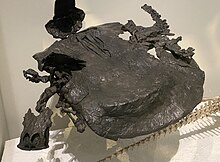| Henodus Temporal range: Late Triassic, 237–227 Ma PreꞒ Ꞓ O S D C P T J K Pg N | |
|---|---|

| |
| Skeleton of Henodus at the American Museum of Natural History | |
| Scientific classification | |
| Domain: | Eukaryota |
| Kingdom: | Animalia |
| Phylum: | Chordata |
| Class: | Reptilia |
| Superorder: | †Sauropterygia |
| Order: | †Placodontia |
| Family: | †Henodontidae |
| Genus: | †Henodus Huene, 1936 |
| Species: | †H. chelyops |
| Binomial name | |
| †Henodus chelyops Huene, 1936 | |
Henodus (from Greek: ἑνός henós, 'one' and Greek: ὀδούς odoús, 'tooth') is an extinct placodont of the Late Triassic period during the early Carnian age. Fossils of Henodus chelyops were found in the Estherienschichten Member of the Grabfeld Formation, near Tübingen, Germany. It was around 1 metre (3.3 ft) in length. The single species within the genus is H. chelyops.
Henodus is the only placodont thus far found in non-marine deposits, suggesting it may have lived in brackish or freshwater lagoons.
Description


Henodus, like many other placodonts, had a superficial resemblance to a turtle. Like turtles, it had a shell formed from a plastron on the underside and a carapace on top. The carapace extended well beyond the limbs, and was made up of individual plates of bony scutes covered by plates of horn. However, the shell was composed of many more pieces of bone than that of turtles, forming a mosaic pattern. The armor was fused to its spine, and its limbs were situated in normal positions, unlike the turtle, where they are located inside the ribcage. The weak limbs of Henodus suggest it spent little, if any time on land.
Henodus also had a single tooth on each side of its mouth, though the remaining teeth were replaced by a beak. In addition, it had baleen-like denticles along the jaws, which combined with a unique feature of the hyoid and musculature indicative of rapid jaw closing indicate a filter feeding lifestyle. The head was squared-off at the front, just ahead of the eyes.
Paleo-ecology
More recently, however, it has been suggested that this placodont was an aquatic herbivore, scraping off vegetation from the bottom with its broad jaws. This suggestion has been brought up in a paper discussing the habits and morphology of Atopodentatus, another Mesozoic aquatic reptile formerly suggested to be a filter-feeder and bearing strongly convergent jaw adaptations, including a similar "hammerhead" jaw tips, though unlike Atopodentatus it's still believed that Henodus relied on filter feeding to obtain plant-matter from the substrates.
References
- "Fossilworks: Gateway to the Paleobiology Database". Paleobiology Database. Retrieved 25 January 2022.
- Henodus chelyops, ein neuer placodontier. - Sonder-Abduck aus Palaeontographica Beiträge zur Naturgeschichte der Vorzeit, Abteilung A 84:99-148. - F. von Huene - 1936.
- Der Dritte Henodus ergänzungen zur Kenntnis des Placodontiers Henodus chelyops Huene. - Sonder-Abdruck aus Palaeontographica Beiträge zur Naturgeschichte der Vorzeit, Abteilung A 89:105-114. - F. von Huene - 1938.
- Palmer, D., ed. (1999). The Marshall Illustrated Encyclopedia of Dinosaurs and Prehistoric Animals. London: Marshall Editions. p. 71. ISBN 1-84028-152-9.
- Rieppel, O. (2002). Feeding mechanisms in Triassic stem-group sauropterygians: the anatomy of a successful invasion of Mesozoic seas Zoological Journal of the Linnean Society, 135, 33-63
- Naish, D. 2004. Fossils explained 48. Placodonts. Geology Today 20 (4), 153-158.
- Li Chun, Olivier Rieppel, Cheng Long and Nicholas C. Fraser, The earliest herbivorous marine reptile and its remarkable jaw apparatus, Science Advances 06 May 2016: Vol. 2, no. 5, e1501659 DOI: 10.1126/sciadv.1501659
Further reading
- National Geographic, December 2005, p. 79, by Virginia Morrell
- Dixon, Dougal. The Complete Book of Dinosaurs. Hermes House, 2006
- Huene F von 1936. Henodus chelyops, ein neuer Placodontier. Palaeontographica A, 84, 99-147.
- Rieppel OC and Zanon RT 1997. The interrelationships of Placodontia. Historical Biology: Vol. 12, pp. 211–227
- Rieppel O 2000. Sauropterygia I. Placodontia, Pachypleurosauria, Nothosauroidea, Pistosauroidea. Handbuch der Paläoherpetologie, Teil 12A. München, Friedrich Pfeil.
- Rieppel, O. (2002). Feeding mechanisms in Triassic stem-group sauropterygians: the anatomy of a successful invasion of Mesozoic seas. Zoological Journal of the Linnean Society, 135, 33-63
- Darren Naish: Fossils explained 48. Placodonts. Blackwell Publishing Ltd, Geology Today, Vol. 20, No. 4, July–August 2004 online
![]() Media related to Henodus at Wikimedia Commons
Media related to Henodus at Wikimedia Commons
| Taxon identifiers | |
|---|---|
| Henodus | |






